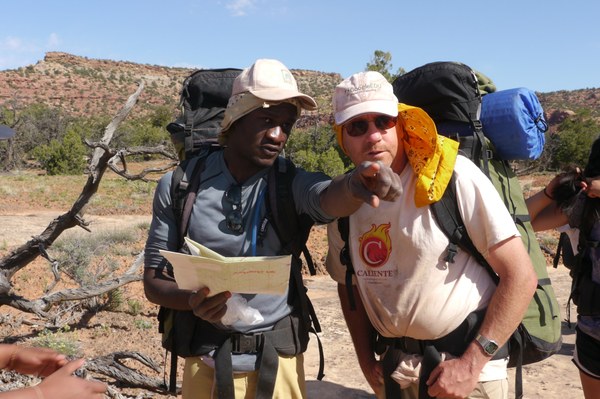
John Abel has been a NOLS instructor since 1991, and has a Masters in Leadership and Organizational Development from the Leadership Institute of Seattle. Since 2010, he has worked primarily for NOLS Professional Training, teaching leadership seminars for NOLS Instructors, and facilitating various leadership training programs for NOLS organizational clients.
You’ve taught leadership courses at NOLS for over 20 years, and received great feedback from last year’s Conference. You’ve discussed and taught the different roles and skills someone in a leadership position can use, but what have you found, if anything, that helps a person start seeing themselves as a leader in the first place? Are there any insights you can provide that help people transition into seeing themselves as “leaders” for the first time (rather than “students” or “participants”)?
Role-modeling and mentoring are particularly important for people who don’t see themselves as leaders, or question if they’re ready to step into a leadership role. Many times when people don’t think of themselves as leaders it’s because they have a strict concept of what a leader must be (usually loud, social, and directive), and they don’t see themselves as naturally that way. If they can see a role model with a similar personality to theirs (and perhaps a more developed outdoor skill set) they watch that person lead, and think, perhaps for the first time, “Wow, I can do that too.”
Similarly, a mentor can help a developing leader by providing honest feedback while directing the new leader to smaller leadership opportunities to boost their confidence. Even small leadership asks that get people using their voice to a group, like, ‘could you study the map and explain tomorrow’s travel day to everyone?’ can make a big difference. Often when someone we look up to expects leadership from us, we begin to act like leaders.
By using a word like “leadership,” do you think that certain types of personalities are attracted to such positions just because of their title? Do you see any ways to prevent putting people in these positions who only want the ‘glory’ but aren’t interested in the burdens?
I think you need three things to do this: clear qualifications, clear expectations, and careful observation. Qualifications and expectations let people know upfront that the ‘glory,’ for those who seek it, comes with a requirement of serving one’s participants and the greater organization. Qualifications and expectations should be a public and unambiguous list of desired skills, behaviors and attitudes that support the type of leader (and participant outcomes) that you want. For example, ‘works patiently with less skilled/fit participants,’ and ‘adapts style to teach inclusively to all types of participants,’ are great expectations for an outdoor leader. You also need a sufficiently robust selection and observation processes to enable you to identify and coach your glory seekers. Often these people can become great leaders and teachers once they learn that sharing what they know can be even more rewarding than showing what they can do.
 John (right) instructing a course at NOLS. Photo courtesy of NOLS.
John (right) instructing a course at NOLS. Photo courtesy of NOLS.
Do you have thoughts about mandated volunteering requirements or other recruiting techniques that have the potential to undermine healthy leadership styles? I’m not suggesting that mandated volunteer requirements are inherently bad, but what are your thoughts on them?
The potential problem I see with mandated volunteering is that it might put people into leadership positions that they don’t really want, or even resent having to take on, and their performance may reflect that. A program that assigns positions of leadership needs to be very clear about what it expects from people, and what it will provide them in return, just like a job. If I agree to a set of terms that I fully understand, then fulfilling them is a way of honoring my word, whether I get paid or not.
At the same time, almost paradoxically, a program must be able to both enforce its standards when it needs to, and flex them when it’s not getting enough (or the right kind of) volunteers. This requires regular communication between the program and its volunteers. If you can’t find people to take on leadership roles, or chores for that matter, it could be symptomatic of another problem somewhere else. Perhaps the people you’re asking to lead don’t see the connection between the work and the goals they value. Perhaps it isn’t what they were expecting, or they don’t fully agree with the goals you’re asking them to support. Maybe the organization lacks alignment around who it is and what it’s really trying to accomplish. In any case, low enthusiasm among volunteers could be a sign that the whole organization needs to have a larger conversation.
Do you have any examples of such pitfalls that you can describe for us?
A while back at NOLS we established qualifications and expectations for instructors working various course types. One requirement we had for climbing said that instructors must be able to climb 5.8 — a modestly challenging level that novices might struggle with. We got a lot of people who had only climbed a few 5.8s, on short, well-rehearsed routes in fairly controlled situations. This was less than we were looking for because our climbing instructors often work with inexperienced students on long, unfamiliar routes with unpredictable variables such as loose rock and mountain weather.
This led to a lot of frustration for everyone, and generally safe but less than optimal outcomes. In the end, we changed our expectation to read, “climbing instructors must be able to onsight lead and manage up to three students on grade III 5.8 routes in the locations they’re hired to work.” This let instructors know we expected them to teach and lead on remote routes that could take several hours to complete, and as a result they self-screened more effectively. All it took was a clearer expectation to make everyone happy.
The pitfalls of ambiguous standards, and lack of standard enforcement apply equally to volunteers and employees.
On the other end of the volunteer experience, how do you talk to people who are already leaders but may not be enjoying the role anymore? What advice do you have for keeping yourself motivated and/or transitioning out of leadership positions?
This is a tricky one. Sometimes people stay in leadership roles after their excitement and learning have waned. Often they do this because the role of ‘outdoor leader’ has become part of their identity, and they don’t want to give up a piece of who they are. It can be an emotional issue for everyone involved. I think you need several things to be successful here. First, you need clear expectations that say, “if you’re not willing to do a, b, and c, we’d prefer that you don’t lead for this organization,” and these expectations should be broad enough that they cover things that an instructor who’s no longer willing to give their best might no longer be doing.
Second, you need an evaluation system that’s honest enough to identify mediocre performance, while still being fair enough to provide room for leaders (even veteran ones) to learn and grow. This is more difficult than it might sound; fostering honest feedback might require changing an organization’s culture.
Third, someone in administration needs to have a conversation with people that the evaluation system identifies as mediocre performers, even if they’ve been stellar performers in the past. This part is particularly difficult (as if the other parts were easy!).
Any tips on how to have those difficult conversations successfully?
In any challenging conversation, I have found a few things to be particularly helpful:
Purge all assumptions from your mind; trust only data. Before you have a conversation with someone you suspect may no longer be enjoying their leadership role, examine your own thinking. Meticulously separate what is information and what is opinion. The differences can be subtle. For example, the statement, ’participants always complain about Bob being unsocial on trips,’ is probably mostly opinion. The information behind it might be more like, ‘three of six participants on each of Bob’s last two trips stated in their evaluations that they would’ve liked him to hang out more in the evenings.’ If you begin the conversation thinking in terms of the first sentence, you’re likely to push Bob into a defensive stance, and your conversation may hit an impasse. If you focus more on the second sentence, Bob may well see the conversation as you and he trying to solve a problem together.
Go in curious. Once the conversation starts your first task should be to get Bob’s side of the story. This is important information that you may not already have, and asking for it shows Bob that your intent is to be even-handed.
Present your bottom lines, and a plan for follow-up if necessary. If your organization is moving in a certain direction, more bridge-building between leaders and participants for example, make this clear to Bob, and reference the communications in which you’ve already tried to make it clear. If he’s willing to adapt his style, make a plan to check in with him after his next trip to see how it goes. If he’s unwilling to adapt, hopefully you’ve had a conversation that will lead to an amicable parting of ways.
In terms of “best practices,” what thoughts do you have about moving people into positions of leadership in a safe and rewarding way?
In outdoor education, I’ve seen two types of people in this regard: those who think they’re ready before they are; and those who don’t think they’re ready until after they are. To address both of these human tendencies, a promotional system should incorporate objective standards, evaluation from subordinates, peers, self and supervisors in written form, or at least with written summaries, and regular conversations between supervisors and individuals about their progression to readiness for a new leadership position.
Thanks so much John. If you only had 20 seconds to motivate someone who was on the fence about taking on a leadership role in the outdoor industry, what would you say?
Mostly, I believe people are their own best decision makers, but if I felt someone was really stuck I might say, ‘I have heard that when we have challenging personal decisions to make, we often act out of either love or fear. How do those emotions affect you in this particular situation, and how would you like to act?
This article originally appeared in our Summer 2016 issue of Mountaineer Magazine. To view the original article in magazine form and read more stories from our publication, click here.
 Chris Williams
Chris Williams